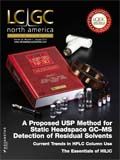HILIC
LCGC North America
This new column explains the essentials of key methods in separation science. This month: hydrophilic interaction chromatography.
Welcome to "The Essentials," brought to you by CHROMacademy.com, LCGC's online professional development site for analytical chemists. This new column will deliver key information on topics in separation science. Our inaugural edition considers the increasingly popular chromatographic mode of hydrophilic interaction chromatography. For each topic, an in-depth tutorial will be available for free at www.CHROMacademy.com/essentials for a month following publication.
What Is HILIC?
Hydrophilic interaction chromatography (HILIC) is a chromatographic mode used to exploit differences in analyte polarity. In HILIC, the strong solvent is water, and usually acetonitrile is the weak solvent. The mechanisms of retention include partitioning into an adsorbed water layer at the stationary-phase surface, adsorption, and ion-exchange, in a complex interplay that depends, in some instances, on the eluent pH and buffer ion concentration.
Why Use HILIC?
The mechanism of retention in HILIC is orthogonal to that of reversed-phase high performance liquid chromatography (HPLC), and thus it is especially useful for separating polar and ionizable analytes that show poor retention or tailing under reversed-phase conditions.
In addition, HILIC-mode eluents typically contain organic and aqueous components. This combination helps overcome some challenges of normal-phase eluent systems, including limited polar (and polar biological) analyte solubility, difficulty switching HPLC equipment from reversed-phase to normal-phase modes, and the cost and environmental impact associated with disposal of large volumes of organic solvent.
What Can I Expect?
In simple HILIC mode, the elution pattern resembles the inverse of a reversed-phase separation. As a first approximation of what you expect to see, flip over your reversed-phase chromatogram (Figure 1). HILIC also will show separation of neutral polar analytes that might be coeluted in reversed-phase mode.

Figure 1: For the polar ranitidine molecule, retention and response are poor under (a) reversed-phase conditions, but good under (b) typical HILIC conditions. (Reproduced with permission from Agilent Technologies.)
Understanding Retention in HILIC
Any polar stationary phase can be used in HILIC mode. Polarity can come from surface silanol moieties or from a bonded phase's polar groups. Functionalized silicas are extensively used because of their durability and reproducibility. The polar stationary phases can adsorb a "water enriched" layer at the silica surface that is more highly aqueous (hydrophilic) than the general mobile-phase composition. Retention is proportional to the polarity of the analyte and inversely proportional to the polarity of the mobile phase. Because the stationary phase is polar, mobile phases generally comprise a high degree of water-miscible organic solvent with a smaller amount of water (the opposite to reversed-phase HPLC). The difference in polarity between the mobile and stationary phases dictates retention of the generally polar analytes. As the amount of water in the mobile phase is increased, the mobile-phase polarity increases. This facilitates elution of the analyte. Typical HILIC eluent systems contain 70–95% water (1).
Both coulombic (electrostatic) and partitioning mechanisms are important in HILIC. Any electrostatic interaction in HILIC is analogous to aqueous ion-exchange chromatography in which the analyte and "strong solvent" mobile-phase molecules (water in this case), compete for the polar (charged) stationary-phase sites. When buffer ions are included in the eluent, these will also compete for any ionized stationary-phase sites. The partitioning mechanism is a unique feature of HILIC chromatography, and is driven by the relative solubility of the analyte in the mobile phase and the hydrophilic layer of bound water at the stationary-phase surface. Partitioning processes analogous to liquid–liquid extraction occur at the interface of the eluent, and bound water layer and analytes partitioning strongly into the bound layer exhibit increased retention (2). A minimum of 3% water generally is required to obtain a significant and usable hydration layer at the stationary-phase surface (3).
References
(1) D.V. McCalley and U.D. Neue, J. Chromatogr. A 1192, 225–229 (2008).
(2) A.J. Alpert. Anal. Chem. 80, 62–76 (2008).
(3) D.V. McCalley, J. Chromatogr. A 1171, 46–56 (2007).
(4) A.J. Alpert et al., Anal. Chem. 82, 5253–5259 (2010).

Assessing Thorium-Peptide Interactions Using Hydrophilic Interaction Liquid Chromatography
February 4th 2025Paris-Saclay University scientists used hydrophilic interaction liquid chromatography (HILIC) coupled to electrospray ionization mass spectrometry (ESI-MS) and inductively coupled plasma mass spectrometry (ICP-MS) to assess thorium’s interaction with peptides.

.png&w=3840&q=75)

.png&w=3840&q=75)



.png&w=3840&q=75)



.png&w=3840&q=75)







